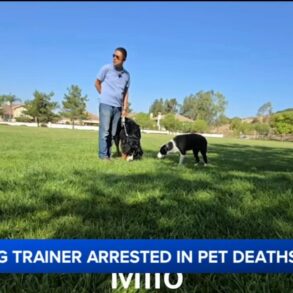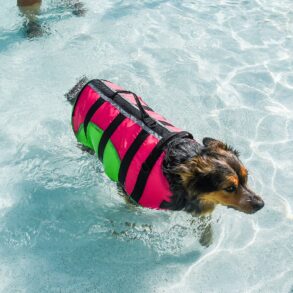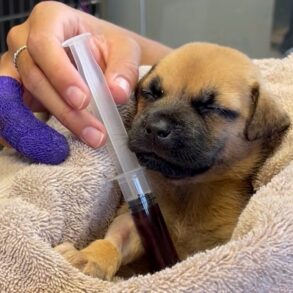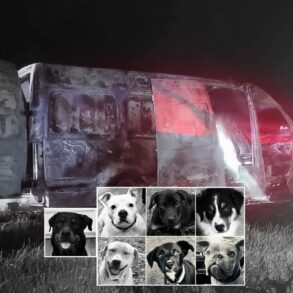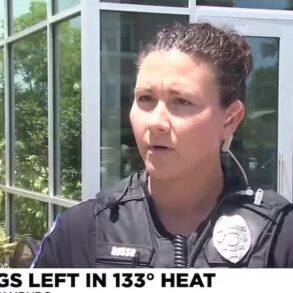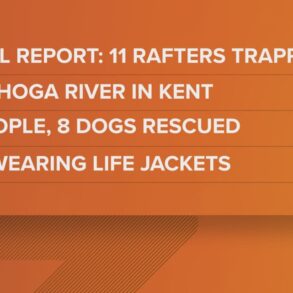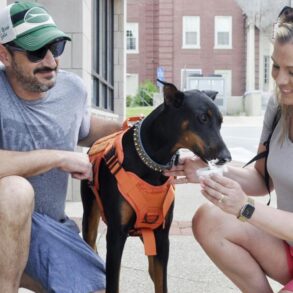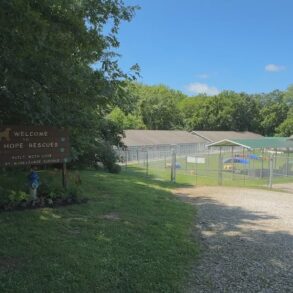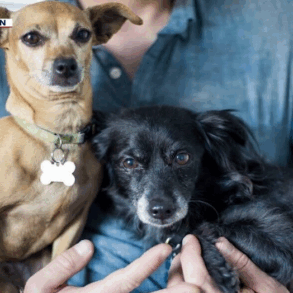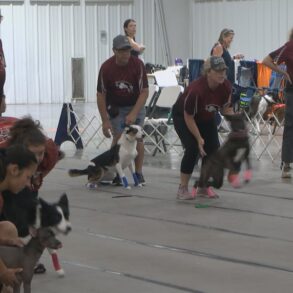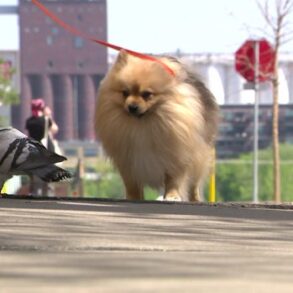
A pair of dogs dig for breakfast outside a gas station in Las Vegas on Saturday
morning.
If you live in Las Vegas, you know about the dogs.
You know there are large dog packs running on the streets. Maybe your grandma doesn’t want to walk down by the river because she doesn’t feel safe. Some are feral, while others are pets, and they run all over the place.
Everyone has an opinion about what to do, but things don’t seem to change.
This series will look at animal control issues in Las Vegas, from a solution-oriented point of view, exploring not just the problem, but what we might be able to do about it.
•••
An overhaul of the city’s animal ordinance will aim to tackle the matter of dogs running at large, as well as other issues affecting the welfare of humans and animals alike in Las Vegas.
Mandatory microchipping and clearly defined penalties for those who violate the rules are at the forefront of the changes being proposed.
Mayor David Romero said city officials have been working to make several amendments to the city’s animal ordinances since he took his current office back in January.
Romero, along with City of Las Vegas Animal Care Center Manager Bea Gallegos, Contracted City Attorney Ambrosio Castellano, Police Chief Caleb Marquez and several animal advocates have been conducting research and having discussions on how best to update the city’s animal ordinance.
Romero estimates the last time the animal ordinances were amended was in the late 1990s or early 2000s.
“Our ordinances are old and they’re vague,” he said, adding that “there’s no teeth” to the current ordinance regulating animals in the city. For example, he said requirements or penalties are not specified within the current ordinance.
Gallegos said the lack of fines and penalties makes it harder to enforce the law. For example, the city’s current ordinance prohibits animals from running at large. Marquez noted this section of the city’s animal ordinance – 118-16 animals running at large.
“It is unlawful for any person to allow or permit any animal to run at large in or upon any street, alley, sidewalk, vacant lot, public property, other enclosed place in the City or private property not belonging to owner of animal,” the ordinance states. Adding clearly defined fines and fees for those who violate the rules is one of the most crucial changes being proposed for the ordinance, said Gallegos.
“Having consequences for these things is really important to show that it’s not OK to just allow animals to run at large,” Gallegos said.
Another major change to be proposed, Gallegos said, is mandatory microchipping.
“For one, it would be a lot easier to get animals back to their owners,” Gallegos said of how microchipping would benefit pets and their owners. “It would give us a better idea of whose animals are running at large.”
Having one’s pets spayed or neutered will also be enforced in the new animal ordinance, Gallegos said. It will be proposed that those who have intact – not spayed or neutered – animals be required to get a special permit. Having litters will also need a special permit under the amended ordinance, Gallegos said.
The current animal ordinance only requires that animals have a city license and receive their rabies vaccination.
Proposed amendments to the animal ordinance will also address people who give away puppies in parking lots. A special permit will be required for this, Romero said, and a business can be fined for allowing puppies to be given away on their premises.
Romero said he is advocating for a permitting process when it comes to giving away puppies so that the city can ensure the animals are getting their first shots, are healthy, and get spayed or neutered.
“We’re going to be able to hold irresponsible pet owners accountable, irresponsible breeders accountable, and also irresponsible businesses that allow free puppy giveaways in their parking lots,” Romero said.
Researching ways to amend the animal ordinance has involved looking at animal ordinances from other municipalities of a similar size to Las Vegas, Gallegos said. Consideration has been given to what has worked for other municipalities and what has not.
These municipalities include communities from across New Mexico as well as other states, Gallegos said.
Marquez said a draft of the amended animal ordinance was first presented to the Las Vegas City Council during a regular council meeting on March 20.
There will soon be a public input meeting so the community can weigh in on the proposed changes to the animal ordinance. Once the community has had a chance to speak on the matter, the ordinance will be taken to the city council for approval. City officials are unsure how much longer the process will take, but Marquez said he hopes to have a public input meeting within a month.
Who enforces the city’s animal
ordinance?
Gallegos said that, within the city, animal control officers and police officers enforce the animal ordinance.
“Animal control officers aren’t certified law enforcement, but they are certified animal control officers,” Gallegos noted. “They can do citations.”
When a situation concerning animals arises, depending on the situation, the primary contact would be the animal control officer,” said City Manager Tim Montgomery.
“We also have our CSAs (Community Service Aides) that can assist,” he added.
The city of Las Vegas has six CSAs, Montgomery explained. He said CSAs are not law enforcement officers and do not carry loaded guns. They are uniformed, Montgomery said, and they respond to a variety of issues, not just matters of animal control.
“They act in an enforcement role, they’re just not certified police officers,” Montgomery said.
When someone calls to report that they’ve seen a dog out loose, or they’re aware of an abuse situation or neglect situation, animal control would be the first to respond, Montgomery said.
“If there was, potentially, a pack of dogs … or some sort of nuisance taking place, they can then go to the community service aides,” Montgomery said. “If it were something more violent then that’s when they would call in law enforcement.”
Gallegos said that San Miguel County also has its own animal control officer. Also, Gallegos said, the San Miguel County Sheriff’s Office can enforce rules governing animals. The New Mexico State Police can also enforce the animal ordinance, Gallegos said.
Romero said the city’s governing body is committed to addressing animal welfare and safety. He noted the low-cost spay/neuter clinic that took place at Abe Montoya Recreation Center Aug. 23-26, which was funded by the city.
Funding for a new animal shelter has been secured, Romero said.
“It’s not the full funding, but it’s a good start,” he said of the capital outlay funds that will cover the design and planning stage of the new shelter.
Also, two new animal control trucks have been purchased, Romero said.
“We hear the people, we hear their concerns, and we’re addressing them as best as we can and as fast as we can.”
This post was originally published on this site be sure to check out more of their content.



